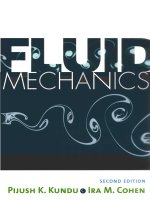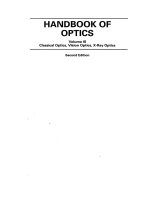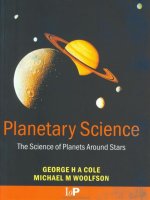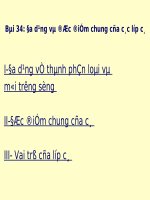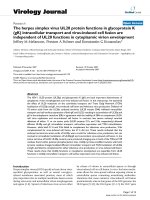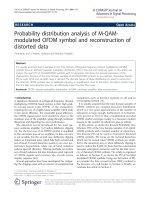LSECOND EDITIONPIJUSH K. KUNDU 0 IRA COHEN M....Fluid Mechanics, Second Edition.Founders of potx
Bạn đang xem bản rút gọn của tài liệu. Xem và tải ngay bản đầy đủ của tài liệu tại đây (28.46 MB, 766 trang )
L
SECOND EDITION
PIJUSH K. KUNDU
0
IRA
M.
COHEN
Fluid Mechanics, Second
Edition
Founders
of
Modern Fluid Dynamics
Ludwig Prandtl
(1875-1953)
G.
I.
Taylor
(18861975)
(Biographical
sketches
of
Prandtl
and
Taylor
are
given in Appendix
C.)
Photograph
of
Ludwig Prandtl is reprinted with permission
from
the
Annual Review
of
Fluid
Mechanics,
Vol.
19, Copyright 1987 by
Annual
Reviews www.AnnualReviews.org.
Photograph
of
Geoffrey
Ingram
Taylor at age 69
in
his laboratory
reprinted
with permission
from
the
AIP
Emilio
See
Visual
Archieves. Copyright, American Institute
of
Physics,
2000.
Fluid
Mechanics
Second
Edition
Rjucsh
K.
Kundu
Oceanographic Center
Nova
Universily
Dmiu. Florida
Ira
M.
Cohen
Departnient
of
Mechanicid En.gineering and
Applied Meclurnics
Universiry
of
Pennsylvania
Philadelphici, Pennsylvania
with
a
chapter
on
Computational
Fluid
Dynamics
by
Howard
H.
Hu
ACADEMIC
PRESS
A HarcourL Sciencc and Technology Company
San
Diego
San Francisco
New
York
Boston London Sydney
Tokyo
Coverphoto:
Karman
vortex
street
behind a ckular cylindcr at
R
=
1
OS.
Photograph
by Sadatoshi Taneda
Coverphoto:
Karmnn
vortex
street
behind a circular cylinder at
R
=
140. Photograph
by Snd;ltoshi Taneda
This
book
is printcd
on
acid-frcc
paper.
@
Copyright
02002,1990
by
Elsevier
Science
(USA).
All Rights
Reserved.
No
part
of
this publication may be reproduced or
transmitted
in
any
form
or
by
any
means,
electronic
or
mechanical, including photocogy, recording,
or
any
information
storage
and
retrieval
system,
without permission in writing
from
the publisher.
Requests
for
permission
to
make
copies
of
any part
of
the
work
should
be
mailed to:
Permissions Department, Academic
Pms,
6277
Sea
Harbor
Drive,
Orlando,
Florida 32887-6777
Academic
press
An
imprint afElsevier
Science
525
B
Streek
Suite
1900,
San
Diego, California
92101-4495,
USA
Academic
Press
84 Theobalds
Road,
hdon
WClX
8RR,
UK
Library
orcOngress
Catalog
Card
Numbcr: 2001086884
International Standard
RookNumber:
0-12-1782514
PRIMED
m-
THE
=D
STATES
OF
AMERICA
02
03
04
Hp
9
8
7 6 5 4
3
2
The second
edition
is dedicated
to the memory
of
pijush
K.
Kundu and
also
to
my
wife
Linda
and
daughters
Susan
and
Nancy
who
have greatly
enriched
my
life.
“Everything
should
be made
as
simple
as possible,
but not simpler.”
-Albert
Einstein
“Ifnature were not beauhB1, it
would
not be
worth
studying it.
And
life
would
not be
worth
living ”
-Henry
Poincad
In
memory
of
Pijush
Kundu
Pijush Kanti Kundu was born in Calcutta,
India, on October
31, 1941.
He received a
B.S.
degree
in Mechanical Engineering in
1963
from Shibpur Engineering College of
Calcutta University, earned an M.S. degree
in Engineering from Roorkee University in
1965,
and was a lecturer in Mechanical Engi-
neering at the Indian Institute of Technology
in Delhi from
1965
to
1968.
Pijush came to
the United States in
1968,
as a doctoral stu-
dent at Penn State University. With Dr. John
L. Lumley as his advisor, he studied instabili-
ties of viscoelastic fluids, receiving his doctor-
ate in
1972.
He began his lifelong interest in
oceanography soon after his graduation, working
as
Research Associate in Oceanog-
raphy at Oregon State University from
1968
until
1972.
After spending a year at the
University de Oriente in Venezuela, he joined the faculty of the Oceanographic Center
of Nova Southeastern University, where he remained until his death in
1994.
During his career, Pijush contributed to a number of sub-disciplines in physical
oceanography, most notably in the fields of coastal dynamics, mixed-layer physics,
internal waves, and Indian-Ocean dynamics. He was a skilled data analyst, and, in
this
regard, one of his accomplishments was to introduce the “empirical orthogonal
eigenfunction” statistical technique to the oceanographic community.
I
arrived at Nova Southeastern University shortly after Pijush, and he and
I
worked
closely together thereafter. I was immediately impressed with the clarity of his scien-
tific thinking and his thoroughness.
His
most impressive and obvious quality, though,
was his love of science, which pervaded
all
his activities. Some time after we met,
Pijush opened a drawer in a desk in his home office, showing me drafts of several
chapters to a book he had always wanted to write. A decade later, this manuscript
became the first edition of “Fluid Mechanics,” the culmination of his lifelong dream;
which he dedicated to the memory of his mother, and to his wife Shikha, daughter
Tonushree, and son Joydip.
Julian P. McCreary, Jr.,
University of Hawaii
Contents
Preface
xvii
Preface
to
First
Edition
xix
Author’s
Notes
xxiz
~~huplt?r
1
1.n
troduction
1
2
1.
Fluid Mechanics
2.
Units
of
Measurement.
3.
Solids, Liquids, and
Gases.
3
4.
Continuum Hypothesis
4
5.
Transport Phmomena
6.
Surfacc
Tension
7.
FluidStatics
9
8.
Classical Thcrmodynamics
12
9.
Perfcct:
Gas
10.
Static Equilibrium
of
a
Compressible Medium
17
Exercises
22
Literature Cited
23
Supplemcntal Reading
23
5
8
16
Uiqter
2
(lartcsian
X:nsors
1.
ScalarsandVeclors
24
2.
Rotation
of
Axes: Formal Dcfinition
of
a Vector
25
vi
i
3
.
4
.
5
.
6
.
7
.
8
.
9
.
10
.
11
.
12
.
13
.
14
.
15
.
16
.
Multiplication
of
Matices
Second-Order Tensor
Contraction and Multiplication
Force on a Surface
Kronecker Delta and Alternating Tensor
Dot Product
Cross Product
Operator
V:
Gradient. Divergence.
and
Curl
Symmetric and Antisymmetric Tensors
Eigenvalues and Eigenvectors
of
a
Symmetric Tensor
Gauss’ Theorem
Stokes’ Theorem
Comma Notation
Boldface versus hdicial Notation
Exercises
Literature Cited
Supplemental Reading
Chapter
3
Kinematics
1 .
2
.
3
.
4
.
5
.
6
.
7
.
8
.
9
.
10
.
11
.
12
.
13
.
14
.
Introduction
Lagrangian and Eulerian Specifications
Material Derivative
Stredine. Path Line. and
Streak
Line
Reference Frame and Streamline Pattern
Linear
Strain
Rate
Shear Strain Rate
Vorticity and Circulation
Relative Motion near a Point: Principal
Axes
Kinematic Considerations
of
Parallel Shear Flows
Kinematic Considerations
of
Vortex
Flows
One
Two
and Three-Dimensional Flows
The Stxamfunction
Polar Coordinates
Exercises
Supplemental Reading
28
29
31
32
35
36
36
37
38
40
42
45
46
47
47
49
49
50
51
52
53
56
56
58
58
60
63
65
68
69
72
73
75
1
.
2
.
3
.
4
.
5
.
6 .
7
.
8
.
9
.
10
.
11
.
12
.
13
.
14
.
15
.
16
.
I7
.
18
.
19
.
Tntmduction
Timc Derivatives
of
Volume lntegrals
Conservation
of
Mass
Streamfunctions: Revisited and Generalized
Stress
at a Point
Conservation
of
Momcntum
Angular Momentum Principle
for
a Fixed Volume
Constitutivc Equation
for
Newtonian Fluid
NavierStokcs Equation
Rotating Frame
Origin
of
Forces
in
Fluid
Momentum
Principle
for
a Fixed Volume
Mcchmical Energy Equation
First Law
of
Thermodynamics:
Thermal
Energy Equation
BcrnouUi Equation
Applications
of
Bernoulli's Equation
Boussincsq Approximation
Boundary Conditions
Exercjscs
Lileraturc Cited
Second Law
or
Thermodynamics: Entropy Production
Supplemcntal Reading
1
.
2
.
3
.
4
.
5
.
6
.
7
.
8
.
Tntroduc tion
Vortex Lines and Vortcx Tubes
Role
of
Viscosity
in
Rotational and Irrotational Vortices
Kclvin's Circulation
Theorem
Vorticity Equation in a Nonrotating Fmme
Vorticity Equation in a Rotating Frame
Intcraction
ol
Vortices
Vortcx Shect
Excrcises
76
77
79
81
82
84
86
88
92
94
97
99
104
108
109
110
114
117
121
122
124
124
125
126
126
130
134
136
141
144
145
Literature Cited
146
Supplemental Reading
147
Ctuqter
6
1rrotati.onal
Flow
1
.
2
.
3
.
4
.
5
.
6
.
7
.
8
.
9
.
10
.
11
.
12
.
13
.
14
.
15
.
16
.
1.7.
18
.
19
.
20
.
21
.
22
.
Relevance
of
Irrotational
Flow Theory
Velocity Potential: Laplace Equation
Application
of
Complex Variables
Flow at a Wall Angle
Sources and Sinks
Irrotational
Vortex
Doublet
Flow past a Half-Body
Flow past a Circular Cylinder without Circulation
Flow past a Circular Cylinder with Circulation
Forces on a lbo-Dimensional Body
Source near a Wall: Method
of
Images
Flow around
an
Elliptic Cylinder with Circulation
Uniqueness
of
Trrotational Flows
Numerical Solution
of
Plane
Trrotational Flow
Axisymmetric Irrotational Flow
Streamfunction and Velocity Potential for hisymmetric Flow
Simple Examples
of
Axisymmetric Flows
Flow
around a Streamlined Body
of
Revolution
Flow around an Arbitrary Body
of
Revolution
Concluding Remarks
Exercises
Literam Cited
Supplemental Reading
Confonnal Mapping
148
150
152
154
156
157
157
159
160
163
166
170
171
173
175
176
181
184
185
187
188
.I
89
190
192
192
chi!pter
7
Gravity
Waves
1
. Introduction
194
2
.
TheWaveEquation
194
3
.
WavcParameters
196
4
. SurfaceGravity Waves
199
5
. Some Features
of
Surface Gravity Waves
203
6 .
7
.
8
.
9
.
10
.
1
I
.
12
.
13
.
14
.
15
.
16
.
17
.
18
.
19
.
20
.
21
.
Approximalions
for
Deep and Shallow Water
Tnfluence
of
Surface Tension
Standing Wavcs
Group Velocity and Energy
Flux
Group Vclocity and Wave Dispersion
Nonlinear Steepening in a Nondispersive Medium
Hydraulic Jump
Finite Amplitude Waves
of
Unchanging
Form
in
a Dispersive Medium
Stokes' Dri
It
Wavcs at a Density Interrace between Infinitely Decp Fluids
Waves in
a
Finitc Layer Overlying
an
Infinitely Deep Fluid
Shallow Layer Overlying an Inhitcly Deep Fluid
Equations
of
Motion
for
a Continuously Stratified Fluid
Internal Wavcs in a Continuously Stratificd Fluid
Dispersion
of
Jntcrnal Wavcs
in
a Stratified Fluid
Encrgy Considerations of Internal Wavcs in a Stratified Fluid
Exercises
Litcrature Cited
1
.
Tntroduction
2
.
Nondimensional Parameters Determined from Differential Equations
3
.
Dimensional Matrix
4
.
Buckingham's Pi Theorem
5
.
6 .
7
.
Nondimensional Parameters and Dynamic Similarity
Commcnls on
Model
Testing
Significance
of
Common Nondimensional Parametcrs
Exerciscs
Litcrature Cited
Supplemcnlal Reading
I
.
Introduction
2
.
Analogy between Heat and Vorticity Diffusion
3
.
Pressure
Change Due
to
Dynamic Effects
209
213
216
218
221
225
227
230
232
234
238
240
242
245
24a
250
254
255
256
257
261
262
264
266
268
270
270
270
271
273
273
CMtml8
xii
4
.
5
.
6
.
7
.
8
.
9
.
10
.
11
.
12 .
13
.
14
.
15
.
Steady Flow between Parallel Plates
Steady
Flow
in a Pipe
Steady Flow between Concentric Cylinders
Impulsively Started Plate: Similarity Solutions
Diffusion of a Vortex Sheet
Decay
of
a
Line Vortex
Flow
Due
to
an
Oscillating Plate
High and Low Reynolds Number Flows
Creeping Flow around a Sphere
Nonuniformity
of
Stokes’ Solution and
Oseen’s
Improvement
Hele-Shaw Flow
Final
Remarks
Exercises
Literature Cited
Supplemental Reading
(Xapter
10
Boundary
Layers
and
Related
Topics
1
.
2
.
3
.
4
.
5
.
6
.
7
.
8
.
9
.
10
.
11
.
12
.
13
.
14
.
15
.
16
.
17 .
Introduction
Boundary Layer Approximation
Different Measures
of
Boundary Layer
Thickness
Boundary Layer on a Flat plate
with
a Sink at the Leading Edge
Boundary Layer on a Flat Plate: Blasius Solution
von
Karman
Momentum Integral
Effects
of
Pressure
Gradient
Separation
Description
of
Flow past a Circular Cylinder
Description
of
Flow past a Sphere
Dynamics
of
Sports Balls
Two-Dimensional Jets
Secondary Flows
Perturbation Techniques
An Example of a Regular Perturbation Problem
An
Example
of
a
Singular Perturbation Problem
Decay
of
a Laminar Shear Layer
Exercises
Literature Cited
Supplemental Reading
274
277
279
282
289
290
292
295
297
302
306
308
309
311
311
312
313
318
321
323
332
335
336
339
346
347
350
358
359
364
366
371
374
376
377
Chpter
3
I
Computational
Fluid
Dynamics
by
Hom7arcl€I
.
Hu
1
.
Tntroduction
2
.
Finite Differcnce Method
3
.
Finite Element Method
4
.
Incomprcssible Viscous Fluid
Flow
5
.
Two
Examples
6
.
Concluding Remarks
Exercises
Literature Cited
1
.
2
.
3
.
4
.
5
.
6
.
8
.
9
.
10
.
11
.
12 .
‘I
3
.
14
.
TI
I
.
Tntroduction
Method
of
Normal
Modes
Thermal Instabilily:
The
Bknard Problem
Double-Diffusive Instability
Ccncrifugal Instability: Taylor Problem
Kelvin-Helmholtz Instability
Instability
of
Continuously Stratified Parallel
Flows
Squids Theorem and Orr-Sommerfeld Equation
Tnviscid Stability
of
Parallel
Flows
Some Results
of
Parallel Viscous Flows
Experimental Verification
of
Boundary Layer Instability
Comments on Nonlinear Effects
Transition
Deterministic Chaos
Exercises
Literature Cited
Uurpler
13
‘li.xhmlcncc
‘1
.
Tiitroduction
2
.
Historical
Notes
3
.
Avcrages
4
.
Correlations and Spectra
5
.
Averaged Equations
of
Motion
378
380
385
393
406
424
427
428
430
431
432
444
448
453
461
467
471
475
480
482
483
485
493
495
4%
498
499
502
506
6 .
7
.
8
.
9
.
10
.
11
.
12
.
13
.
14
.
15
.
Kinetic Energy Budget
of
Mean How
512
Kinetic Energy Budget
of
Turbulent Flow
514
Turbulence Production and Cascade
517
Spectrum
of
Turbulence
in
Inertial Subrange
524
Wall-Free Shear Flow
522
Wall-Bounded Shear Flow
528
Eddy Viscosity and Mixing Length
536
Coherent Structures in a Wall Layer
539
Turbulence
in
a Stratified Medium
540
Taylor’s Theory
of
nrbulent Dispersion
546
Exercises
552
Literature Ciled
553
Supplemental Reading
554
Chapter
I4
Geophysical
Fluid
Dynamks
1
.
2
.
3
.
4
.
5
.
6
.
7
.
8
.
9
.
10
.
11
.
12
.
13
.
14
.
15
.
16
.
17 .
18
.
Introduction
Vertical Variation
of
Density
in
Atmosphere and Ocean
Equations
of
Motion
Approximate Equations for a
Thin
Layer
on
a Rotating Sphere
Geostrophic
Flow
Ekman
Layer at
a
Frec Surface
Ekman
Layer on a Rigid Surface
Shallow-Water Equations
Normal
Modes
in
a Continuously Stratified Layer
High- and
Low-Frequency
Regimes
in
Shallow-Water Equations
.
.
Gravity Wavcs with Rotation
Kelvin
Wave
Potential Vorticity Conservation in Shallow-Water
Thcory
Internal Waves
Rossby Wave
Barotropic Instability
Baroclinic Instability
Geostrophic Turbulence
Exercises
Literature
Cited
555
557
559
562
564
569
574
577
579
586
588
591
595
598
(108
613
615
623
626
627
1
.
2 .
3
.
4
.
5
.
6
.
7
.
E
.
9
.
10
.
11
.
12
.
13
.
14 .
d
I
ntroduc Lion
The
Aircraft and Tts Controls
Airfoil Geometry
Forces on an Moil
Kutta Condition
Generation of Circulation
Conformal Transformation
for
Generating Airfoil Shape
Lift of Zhukhovsky Airroil
Wing
of
Finite Span
Lifting Line Theory
of
Prandtl and Lanchester
Rcsults
for
Elliptic Circulation Distribution
Li.ft and Drag Characteristics
of
Airfoils
Pmpulsive Mechanisms of
Fish
and Birds
Sailing against the Wind
Exercises
Litcrahre Cited
Supplemental Reading
(.'hplm
16
Compressihle
Flow
1
.
2
.
3
.
4
.
5
.
6
.
7
.
8
.
9
.
IO
.
11
.
12
.
Introduction
Speed of Sound
Basic Equations
for
One-Dimensional
Flow
Stagnation and Sonic Propcrties
Area-Velocity Relations
in
One-Dimensional Isentropic
Flow
Normal
Shock Wave
Operdtion
of
Nozzlcs at Dimerent Back Pressures
Effects
of
Friction and Heating in Constant-Area Ducts
Oblique
Shock
Wave
Expansion and Compression
in
Supersonic Flow
Mach Cone
Thin
Airfoil Thcory
in
Supersonic
Flow
Exerci scs
629
630
633
633
635
636
638
642
645
646
651
653
655
656
658
660
660
661
665
667
671
676
680
685
690
694
696
700
702
704
xvi
Ctrnteith
Literature Cited
Supplemental
Reading
+pen&
A
Some
Properties
of
Common
Fluids
A1
.
Useful Conversion Factors
A2
.
Properties
of
Pure
Water at Atmospheric
Pressure
A3
.
Properties
of
Dry
Air at Atmospheric Pressure
A4
.
Properties
of
Standard Atmosphere
Appendix
B
Curvilinear Coordi.nates
B
1
.
Cylindrical Polar Coordinates
B2
.
Plane Polar Coordinates
B3
.
Spherical Polar Coordinates
+per&
C
Founders of
Modern
Fluid
Dynamics
Ludwig Prandtl(l875-1953)
Geofli-ey
Ingram
Taylor (1886-1975)
Supplemental Reading
Index
705
706
707
708
708
709
710
712
712
715
716
717
718
Preface
My involvemcnt with Pijush Kundu’s
FluidMechunics
first began in April 1991 with
a letter
from
him asking
mc
to consider
his
book for adoption in the
first
year graduatc
courSe
1
had been teaching
for
25 ycars. That started a correspondence and, in fact,
I
did
adopt the book lor the following acadcmic ycar. The correspondence related
to improving the book by enhancing
or
clarifying various points.
T
would not have
taken the time to do that
iT
I
hadn’t thought this
was
thc best
book
at the first-year
graduate level. .By the end of that ycar
we
werc alrcady discussing a swond edition
and whether
1
would have a role in it.
By
early 1992, howcvcr, it was clcar that
T
had a crushing administrative burden at the University
or
Pennsylvania and could not
undertake any time-consuming projects
for
the next several years. My wile and
1
met
Pijush and Shikha for the first time
in
December 1992. They were a charming, erudite,
sophisticated couple with two brilliant children. We immediately
relt
a bond orwarmth
and €riendship with them. Shikha was a Leacher
like
my wife
so
the
four
of
us
had
a
great deal in common.
A
couple
or
years later we were shocked to hear that Pijush had
died suddenly and unexpectedly. It saddened
me
gcatly bccause
I
M
been looking
forward to working with Yijush on the second edition after my term
as
department
chainnan ended
in
mid-1997. For the next year and a half, howcvcr, scrious family
health problems detoured any plans. Discussions on this cdition resumed in July
ol
1999 and wcrc concludcd in the Spring
or
2000
when my work really started.
This
hook remains thc principal work product
of
Pijush K. Kundu, especially the lengthy
chapters on Gravity Waves, Instability, and Geophysical Fluid Dynamics, his areas
or
expertise.
I
have addcd ncw material to
all
of
the other chapters, often providing an
alternative point
of
view. Specifically, vcctor field derivatives have been generalized,
as
have been streamfunctions. Additional material has been added to thc chaptcrs on
laminar flows and boundary layers.
The
trcatmcnt
of
one-dimensional gasdynamics
has been extended.
Morc
problems have been added to most chapters. ProIessor
Howard H. Hu, a recognized expert
in
computational fluid dynamics, graciously
provided an cntircly new chapter, Chapter
1 1,
thcrchy providing the student with an
entree into this cxploding new field. Both finite diffcrcncc and Gnite element methods
arc
introduced
and a delailed worked-out cxamplc of each
is
provided.
1
have becn
a
studcnt
01
fluid mechanics since 1954 when
I
entered college to
study aeronautical engineering.
I
have been teaching
fluid
mechanics sincc
1963
when
I
joincd
thc
Brown University faculty, and
I
have been teaching a course corresponding
to this book since moving to thc University orPennsylvania in
1966.
I
am
most grdtCfUl
10
two of my own tcahers, Prolessor Wallace
D.
Hayes
(191
8-2001),
who expressed
xvii
xviii
PrcJacw
fluid mechanics in the clearest way
I
have ever
seen,
and Professor Martin
D.
Kruskal,
whose use of mathematics to solve difficult physical problcms was developed to a
high
art
form
and reminds me
of
a
Vivaldi
trumpet concerto.
His
codification of rules
of applied limit processes into the principles of “Asymptotology”
remajns
with me
today
as
a way to view problems.
T
am grateful
also
to countless students who asked
questions,
forcing
me
to
rethink many points.
The editors at Academic
Press,
Gregory Franklin and Marsha Filion (assistant)
have been very supportive
of
my
efforls and have tied to light a
fire
under me. Since
this
edition was completed,
I
found that thcrc is even
more
new and original material
I
would like
to
add. But, alas, that
will
have to wait for the next edition. The new
figures
and modifications
of
old
figures
were donc by Maryeileen Ranford with occasional
assistance
from
the school’s software
expert,
Paul
W.
Shaffer.
I
greatly appreciate
their job well done.
Ira
M.
Cohen
Preface
to First Edition
This book is a basic introduction
to
the subject of fluid mechanics and is intended [or
undergraduate and beginning graduate students of science and engineering. There is
enough material in the
book
for at leaqt two courses.
No
previous knowledge
of
thc
subject is assumed, and much ofthe text is suitable in a
first
course on the subject. On
the other hand, a sclcction of thc dvanccd topics could bc uscd in
a
sccond coursc.
I
have not hied
lo
indicate which sections should be considered advanced; the choice
often depends on the teacher, the university, and the field
of
study. Particular effort
has been
made
to make the presentation clcar and accurate and at thc samc timc cdsy
enough for students. Mathematically rigorous slpprodchcs hslvc bccn avoided in favor
of the physically revealing ones.
A
survey
of
the available texts revealed the need
for
a
book
with
a
balanccd
view, dealing with currcndy rclevant topics, and at the same
time
easy enough for
students. The available tcxts can pcrhaps be divided into three broad groups. One
type, written primarily
for
applied mdthcmaticians, deals mostly with classical topics
such as irrotational and laminar flows, in which analytical solutions
are
possible.
A sccond group
of
books ernphqizes engineering applications, conccntrating on
flows
in
such systems as ducts, open channels, and airfoils.
A
third type
of
text
is
narrowly focused loward applications to largc-scale gcmphysical systems, omitting
small-scale processes which are equally applicablc
to
geophysical system
as
well
as
labordtary-scale phenomena. Several of thcsc geophysical fluid dynamics texts
are
also writlen primarily for researchers and
arc
therefore rather difficult for students.
I
have mcd to adopt a balanced view and to
dcal
in
a
simplc way with the basic ideas
relevant to both cngineering and geophysical fluid dynamics.
However,
I
have taken a rather cautious
altitude
toward mixing enginccring and
geophysical fluid dynamics, gcnerdlly separating them in diffcrcnt chapters. Although
the basic principles arc the same, the large-scalc gcophysical flows
are
so
dorninatcd
by thc cffccts
of
the Coriolis force that thcir characteristics can be quite different
from
those
of
laboratory-scalc flows.
It
is
for
this
reason that
most
effects orplanetary
rotation
are
discusscd
in
a
separate chapter, although the concept of the Coriolis force
is intrnduccd carlierin the
book.
The effects
of
density stratilication, on thc othcr
hand,
are
discusscd in several chapters, sincc thcy can be important in both gcophysical and
laboratory-scalc
flows.
Thc choice
or
malerial is always
a
pcrsonal one. In my c€L
lo
select topics,
howcver,
I
have been careful not
to
be guided strongly by my own research
intcresls.
Thc material selected is what
I
bclieve
to
be of the
most
interest
in
a book on general
xix
fluid mechanics.
It
includes topics of special interat to geophysicists (for example,
the chapters on
Gruvity Waves
and
Geophysical Fluid Dynamics)
and to engineers
(for
example, the chapters on
Aerodynumics
and
Compressible Flow).
There
are
also
chapters
of
common
interest, such as the first five chapters, and those on
Boundary
Layers, Instability,
and
Turhulence.
Somc of the material
is
now
available
only in
specialized monographs; such material is presented here in simple
form,
perhaps
sacrificing
some
formal
mathematical rigor.
Throughout the book the conveniencc of tensor algebra has becn cxploited freely.
My experience is that many students
feel
uncomfortable with tensor notation
in
the
beginning, especially with the permutation symbol
&ok.
After
a while, however, they
like
it.
In
any case, following an introductory chapter, the sccond chapter of the book
explains the fundamentals of
Cartesiun Tensors.
The next three chapters deal with
standard and introductory material
on
Kinematics, Conservution
Laws,
and
Vorticity
Dynamics.
Most
of
the material here is suitable
for
presentation
to
geophysicists
as
well
as
engineers.
In
much
of
the rest
of
the book the teacher is expected to select topics that
are
suitable for his
or
hcr particular audience. Chaptcr
6
discusses
Zrrotational
Flow;
this
material is rather classical but is still useful for
two
reasons. First, some of the results
are
used in later chapters, especially the one on
Aerodynamics.
Second, most
of
the
ideas
are
applicable in the study of other potential fields, such as heat conduction
and electrostatics. Chapter
7
discusses
Gravity Waves
in homogeneous and stratified
fluids; the emphasis
is
on linear analysis, although brief discussions
of
nonlinear
effects such as hydraulic jump, Stokes’s drift, and soliton
am
given.
After
a discussion of
Dynamic Similarity
in Chapter
8,
the study
of
viscous flow
starts
with Chapter
9,
which discusses
Lcsmiizur Flow.
The material is standard, but
thc concept and analysis
of
similarity solutions are explained in dctail.
In
Chapter
10
on
Boundary
Luyers,
the central idea has been introduced intuitively at first. Only
after a thorough physical discussion has the boundary laycr been explained as
a
sin-
gular perturbation problem.
I
ask the indulgence of
my
colleagues for including the
peripheral section on the dynamics
of
sports
balls but promise that most students
will listen with intercst and ask a
lot
of questions.
Instability
of flows is discussed at
some length
in
Chaptcr
12.
The emphasis is on linear analysis, but some discussion
of
“chaos” is given in order to point out how detcrministic nonlinear systems can lead
to irregular solutions.
Fully
developed three-dimensional
Turbulence
is discussed in
Chapter
13.
Tn
addition
to
standard engincering topics such as wall-bounded shear
flows, the theory
a€
turbulcnt dispersion
of
particles is discussed because of
its
geo-
physical importance. Some effects of stratification are
also
discussed here, but the
short section discussing the elerncntary ideas
of
two-dimensional geostrophic tufbu-
lencc is deferred to Chapter
14.
I
believc that much
of
the material in Chapters
8-1
3
will be of general interest, but some selection
of
topics is necessary
hme
for teaching
specialized groups of students.
The remaining
three
chapters deal with more specialized applications in geo-
physics and engincering. Chaptcr
14
on
Geophysical Fluid Dynamics
emphasizes
the linear analysis
of
certain geophysically important wave systems. However, ele-
ments
of
barotropic and baroclinic instabilities and geostrophic turbulcnce
are
also
included. Chapter
15
on
Aerodynamics
emphasizes the application
of
potcntial the-
ory
to flow around lift-generating profiles; an elementary discussion
of
finite-wing
theory is also given. The material is standard, and
I
do not claim much originality
or
innovation, although
I
think the reader may be especially
interested
in the discussions
of propulsive mechanisms of fish, birds, and sailboats and the matcrial on the historic
controversy bctwccn Randtl and Lanchester. Chapter
16
on
Compressible
F~JW
also
conlains standard topics, available in most engineering texts. This chapter
is
included
with
the
bclicf that all fluid dynamicists should have some familiarity with such topics
as shock wavcs and expansion fans. Besides, very similar phenomena
also
occur in
other nondispcrsivc systcms such as gravity waves in shallow water.
The appcndixcs contain conversion factors, properties of water and air, equations
in curvilinear coordinates, and short bibliographical sketches
of
Founders
of
Modem
Fluid
Dyruunic.7.
In
selecting the names in the list
of
foundcrs,
my
aim
was to come
up with a very short list of historic figurcs who madc truly fundamental contributions.
It became clear that the choice oTPrandtl and
G.
I.
Taylor was the only one that would
avoid all controversy.
Some problems in the basic chapters
are
worked out in the text, in order to
illustrate the application of the basic principles. In a first course, undcrgraduatc cngi-
necring studcnts may necd morc practice and hclp than offered
in
the book;
in
that
case the teacher may have to select additional problems from other books. Difficult
problems have been deliberately omitted
from
the end-of-chapter exercises.
It
is my
experience that the more difficult exercises need a lot
of
clarification and hints (the
degree of which depends on the students’ background), and Lhey
are
IhereTore beikr
designed by the kacher. In many caSes answers
or
hints
are
provided
Tor
the exercises.
Acknouhdgt,
Jrnenlx
T
would likc to record hen:
my
gratitudc to those who made the writing
or
his book
possiblc. My teachcrs
Professor
Shankar Lal and Professor John Lumley fostered my
intcrcst in fluid mechanics and quietly inspired me with their brilliance; Professor
Lumley also reviewed Chaptcr
13.
My colleague Julian McCreary provided support,
encouragement, and careful comments
on
Chapters
7,12,
and
14.
Richard Thomson’s
cheerful voice over the telephone was a constant reassurance hat professional science
can
make
some people happy, not simply compctitive;
I
am also grateful to him for
reviewing Chapters
4
and
15.
Joseph Pedlosky gavc vcry valuable comments
on
Chapter
14,
in addition to warning me against too broad a presentation. John Allen
allowed me
to
use his lecture notes on perturbation techniques. Yasushi Fukamachi,
Hyong Lee, and Kevin Kohler commented on several chaptcrs and constantly pointed
out
things that
may
not have been clear to thc students. Stan Middleman and Elizabeth
Mickaily were especially diligcnt in checking my solutions to the examples
and
end-of-chapter problcms. Terry Thompson constantly got me
out
oT
trouble with my
personal computer. Kathy Maxson drafted the figures. Chuck
Arthur
and Bill LaDue,
my cditors at Academic Press, creatcd a delightful atmosphere during thc course of
writing
and production
of
the book.
Lastly,
I
am grateful to Amjad
Khan,
the late
Amir
Khan, and the late Omkarnath
Thakur for heir music, which made working after midnight no chore at all.
1
recom-
mend listening to them if anybody wants to write
a
book!
Pijush
K.
Kundu
